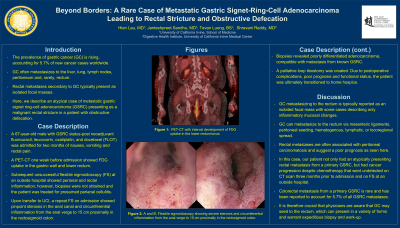Monday Poster Session
Category: Stomach
P3362 - Beyond Borders: A Rare Case of Metastatic Gastric Signet Ring Cell Adenocarcinoma Leading to Rectal Stricture and Obstructive Defecation
Monday, October 28, 2024
10:30 AM - 4:00 PM ET
Location: Exhibit Hall E

Has Audio
- SR
Shravani Reddy, MD
University of California, Irvine
Orange, CA
Presenting Author(s)
Hien Lau, MD, Janteshpreet Sandhu, MD, Tevan Luong, BS, Shravani Reddy, MD
University of California, Irvine, Orange, CA
Introduction: The prevalence of gastric cancer (GC) is rising, accounting for 5.7% of new cancer cases worldwide. GC often metastasizes to the liver, lung, lymph nodes, peritoneum and, rarely, rectum. When rectal metastasis occurs, it is usually reported as isolated focal masses. Here, we describe an atypical case of metastatic gastric signet-ring-cell adenocarcinoma (GSRC) presenting as a malignant rectal stricture in a patient with obstructive defecation.
Case Description/Methods: A 67-year-old male with GSRC status-post neoadjuvant fluorouracil, leucovorin, oxaliplatin, and docetaxel (FLOT) was admitted for two months of nausea, vomiting and rectal pain. A PET-CT one week before admission showed FDG uptake in the gastric wall and lower rectum. Subsequent unsuccessful flexible sigmoidoscopy (FS) at an outside hospital showed perianal and rectal inflammation without tumors, and the patient was treated for presumed perirectal cellulitis. A repeat FS on admission showed pinpoint stenosis in the anal canal and circumferential inflammation from the anal verge to 15 cm proximally in the rectosigmoid colon. Biopsies revealed poorly differentiated adenocarcinoma, compatible with metastasis from known GSRC. A palliative loop ileostomy was created. Due to postoperative complications, poor prognosis and functional status, the patient ultimately transitioned to home hospice.
Discussion: GC metastasizing to the rectum is typically reported as an isolated focal mass with some cases describing only inflammatory mucosal changes. GC can metastasize to the rectum via mesenteric ligaments, peritoneal seeding, hematogenous, lymphatic, or locoregional spread. Rectal metastases are often associated with peritoneal carcinomatosis and suggest a poor prognosis as seen here. Colorectal metastasis from a primary GSRC is rare and has been reported to account for 5.7% of all GSRC metastases. It is therefore crucial that physicians are aware that GC may seed to the rectum, which can present in a variety of forms and warrant expeditious biopsy and work-up.

Disclosures:
Hien Lau, MD, Janteshpreet Sandhu, MD, Tevan Luong, BS, Shravani Reddy, MD. P3362 - Beyond Borders: A Rare Case of Metastatic Gastric Signet Ring Cell Adenocarcinoma Leading to Rectal Stricture and Obstructive Defecation, ACG 2024 Annual Scientific Meeting Abstracts. Philadelphia, PA: American College of Gastroenterology.
University of California, Irvine, Orange, CA
Introduction: The prevalence of gastric cancer (GC) is rising, accounting for 5.7% of new cancer cases worldwide. GC often metastasizes to the liver, lung, lymph nodes, peritoneum and, rarely, rectum. When rectal metastasis occurs, it is usually reported as isolated focal masses. Here, we describe an atypical case of metastatic gastric signet-ring-cell adenocarcinoma (GSRC) presenting as a malignant rectal stricture in a patient with obstructive defecation.
Case Description/Methods: A 67-year-old male with GSRC status-post neoadjuvant fluorouracil, leucovorin, oxaliplatin, and docetaxel (FLOT) was admitted for two months of nausea, vomiting and rectal pain. A PET-CT one week before admission showed FDG uptake in the gastric wall and lower rectum. Subsequent unsuccessful flexible sigmoidoscopy (FS) at an outside hospital showed perianal and rectal inflammation without tumors, and the patient was treated for presumed perirectal cellulitis. A repeat FS on admission showed pinpoint stenosis in the anal canal and circumferential inflammation from the anal verge to 15 cm proximally in the rectosigmoid colon. Biopsies revealed poorly differentiated adenocarcinoma, compatible with metastasis from known GSRC. A palliative loop ileostomy was created. Due to postoperative complications, poor prognosis and functional status, the patient ultimately transitioned to home hospice.
Discussion: GC metastasizing to the rectum is typically reported as an isolated focal mass with some cases describing only inflammatory mucosal changes. GC can metastasize to the rectum via mesenteric ligaments, peritoneal seeding, hematogenous, lymphatic, or locoregional spread. Rectal metastases are often associated with peritoneal carcinomatosis and suggest a poor prognosis as seen here. Colorectal metastasis from a primary GSRC is rare and has been reported to account for 5.7% of all GSRC metastases. It is therefore crucial that physicians are aware that GC may seed to the rectum, which can present in a variety of forms and warrant expeditious biopsy and work-up.

Figure: Figure: A) PET-CT with interval development of FDG uptake in the lower rectum/anus. B and C) Flexible sigmoidoscopy showing severe stenosis and circumferential inflammation from the anal verge to 15 cm proximally in the rectosigmoid colon.
Disclosures:
Hien Lau indicated no relevant financial relationships.
Janteshpreet Sandhu indicated no relevant financial relationships.
Tevan Luong indicated no relevant financial relationships.
Shravani Reddy indicated no relevant financial relationships.
Hien Lau, MD, Janteshpreet Sandhu, MD, Tevan Luong, BS, Shravani Reddy, MD. P3362 - Beyond Borders: A Rare Case of Metastatic Gastric Signet Ring Cell Adenocarcinoma Leading to Rectal Stricture and Obstructive Defecation, ACG 2024 Annual Scientific Meeting Abstracts. Philadelphia, PA: American College of Gastroenterology.
